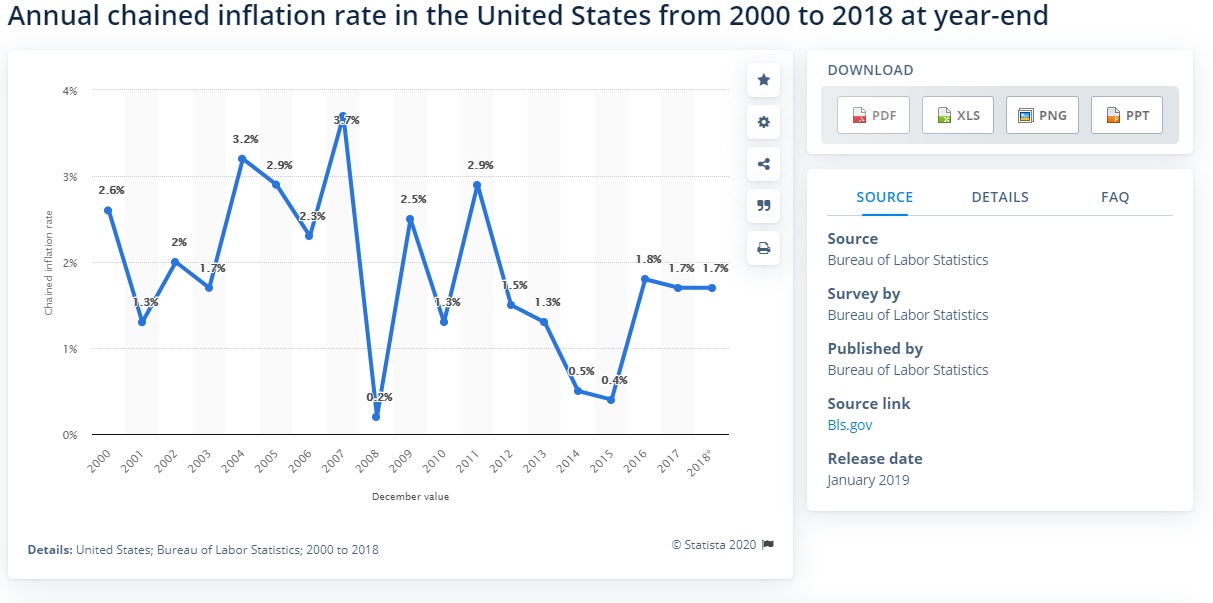Alex Tabarrok is convinced we’re at full employment:
To begin, full employment does not mean the lowest possible unemployment rate. We are at full employment when we are at the natural rate of unemployment… When the production of apples is bigger this year than last year we don’t jump to the conclusion that last year the apple market was out of equilibrium. Similarly, the fact that unemployment was lower this year than last year does not mean that we weren’t at full employment last year.
I’m not so sure. Perhaps the most informative alternate name for the “natural rate of unemployment” is the NAIRU – the Non-Accelerating-Inflation Rate of Unemployment. So if you see low, stable inflation, that could mean you’re at the natural rate. Or it could mean that you’re above it. So what’s been going on lately? This:

Quick version: Inflation has been low and stable for several years. This could mean we’re right at the sweet spot. The more likely scenario, though, is that we’re not quite there yet.
How can we ever find out? The only way to really know is to push our luck a little bit, make monetary policy more expansionary, and see if inflation starts to spiral upwards.
Is that wise? To be honest, I’m conflicted. I find the Akerlof-Dickens-Perry model, which features a long-run inflation-unemployment trade-off, to be quite convincing. I also buy the market monetarist view that a modestly higher inflation target – say 3% – would be a welcome buffer during the next recession. On the other hand, though, the 1970s showed that a casual attitude about inflation can get severely out of hand, leading to chronic stagflation and miserable disinflations.
All things considered, I’d stay the course. Yet if the Fed announced it was going to raise its target rate to 3%, I would not fret.
What I am confident of, though, is that economists are wrong to confidently assert that we’re already “at the natural rate.” Yeah, maybe we are. Still, there’s got to be at least a 30% chance that we remain, say, half a percentage-point above. Remember: If nominal wage rigidity is currently irrelevant in 90% of jobs, but remains a binding constraint in declining occupations and rural areas, then inflation still erodes nominal rigidity and increases overall employment. Is that really so hard to believe?

READER COMMENTS
Thaomas
Jan 9 2020 at 4:37am
I think we are close enough to full employment that the “employment” half of the Fed’d mandate should not move them toward more stimulus. But the price level on the CPE basis is still below what it would have been if they had been meeting their inflation target since 2008, so more stimulus is desirable on those ground. Probably removing the IOR is the best way of doing that a the moment.
Ahmed Fares
Jan 10 2020 at 3:06am
The lack of inflation can be easily explained by the Global Slack Hypothesis. In a global economy, what matters is global slack, not domestic slack.
There are two competing explanations for the demise of the standard, domestic, accelerationist Phillips curve. The first is that because inflation expectations have become firmly anchored at the target (no one doubts the Fed’s willingness or ability to keep inflation in check), the inflation process has mutated so that the relationship that works now is between domestic slack and the level of inflation rather than changes in inflation. There is some evidence to support this hypothesis. See Figure 2. The competing explanation is the Global Slack Hypothesis which says that due to the integration of global markets, what now drives inflation is not domestic slack but rather global slack. Due to competition from global rivals, domestic producers in the tradable sector cannot raise prices when the domestic labor market tightens and wage pressures build. Instead, they either rebalance their global supply chains and off-shore production; or they lose business to their foreign rivals. In either case, domestic inflation is determined as much by global slack as by domestic slack.
The evidence is mounting that the second explanation is the right one. What is especially compelling is the evidence that global slack is statistically significant in ALL countries for which data is available while domestic slack is significant is NONE since 2000. See Figure 3. The last column corresponds to global slack (“foreign gap”); no stars means the variable is not significant; three means it is significant at the 1 percent level.’ —quoted from an internet comment
Thaomas
Jan 10 2020 at 7:24am
The lack of inflation can be easily explained by the Fed having a policy of not allowing the inflation rat to exceed 2% and constraining monetary stimulus to achieve that goal.
Ahmed Fares
Jan 11 2020 at 2:52pm
Where were the Fed’s prodigious powers back in the 1970s when we had double-digit inflation?
bill
Jan 19 2020 at 7:34am
Help me understand why global slack is so different in all these countries.
https://tradingeconomics.com/country-list/inflation-rate
Thanks.
Comments are closed.